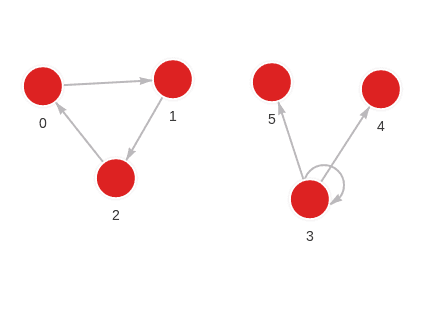weakly_connected_components
The first analysis that is most often run on a graph is usually a search for disconnected components. The algorithm implemented within this module does exactly that, it searches for different components of the graph. Within components, nodes have connections toward each other, while between components there is no edge that connects nodes from separate components.
| Trait | Value |
|---|---|
| Module type | algorithm |
| Implementation | C++ |
| Graph direction | undirected |
| Edge weights | unweighted |
| Parallelism | sequential |
Procedures
You can execute this algorithm on graph projections, subgraphs or portions of the graph.
get()
Use the procedure to get disconnected components.
Input:
subgraph: Graph(OPTIONAL) ➡ A specific subgraph, which is an object of type Graph returned by theproject()function, on which the algorithm is run. If subgraph is not specified, the algorithm is computed on the entire graph by default.
Output:
node➡ Vertex object with all properties which is going to be related to the component ID it belongs.component_id➡ Component ID for each node in the graph. Components are zero-indexed and there is no rule of how they will be appointed to node. The only guarantee is that divided components will have distinct component IDs.
Usage:
Run the following query to get disconnected components:
CALL weakly_connected_components.get()
YIELD node, component_id;Example
Database state
The database contains the following data:

Created with the following Cypher queries:
MERGE (a:Node {id: 0}) MERGE (b:Node {id: 1}) CREATE (a)-[:RELATION]->(b);
MERGE (a:Node {id: 1}) MERGE (b:Node {id: 2}) CREATE (a)-[:RELATION]->(b);
MERGE (a:Node {id: 2}) MERGE (b:Node {id: 0}) CREATE (a)-[:RELATION]->(b);
MERGE (a:Node {id: 3}) MERGE (b:Node {id: 3}) CREATE (a)-[:RELATION]->(b);
MERGE (a:Node {id: 3}) MERGE (b:Node {id: 4}) CREATE (a)-[:RELATION]->(b);
MERGE (a:Node {id: 3}) MERGE (b:Node {id: 5}) CREATE (a)-[:RELATION]->(b);Analyze graph
Get weekly connected components by running the following query:
CALL weakly_connected_components.get()
YIELD node, component_id
RETURN node, component_id;Results:
+-----------------+-----------------+
| node | component_id |
+-----------------+-----------------+
| (:Node {id: 5}) | 1 |
| (:Node {id: 4}) | 1 |
| (:Node {id: 3}) | 1 |
| (:Node {id: 2}) | 0 |
| (:Node {id: 0}) | 0 |
| (:Node {id: 1}) | 0 |
+-----------------+-----------------+